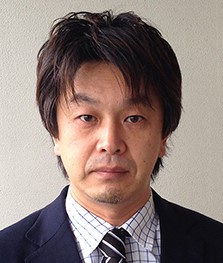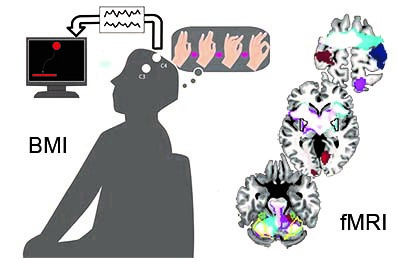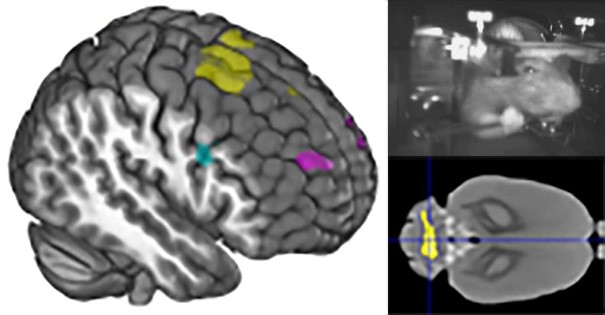
M.D., Ph.D. Professor Takashi Hanakawa
As exemplified by magnetic resonance imaging (MRI), advances in non-invasive measurement of functional neuroanatomy are remarkable, casting new light on electro-chemical networks of healthy and diseased human brain from various perspectives. Nevertheless, there is a large knowledge gap to be filled between the non-invasive brain mapping researches and the traditional neuroanatomy and neuropathology researches. We aim to develop multi-modal neuroimaging including integrated non-invasive macroscopic imaging and postmortem microscopic imaging. We also develop neuro-engineering technology to enhance understanding of causal relationship between brain activity and functions in healthy and diseased brains.
Research and Education
Complex networks consisting of hundreds of trillions of synapses support information processing in the human brain. Understanding of such highly complicated systems requires the understanding of large-scale topological properties of the network as well as functions and structures of their constituents. We will seek to develop multi-modal hierarchical neuroimaging by integrating non-invasive macroscopic imaging and postmortem microscopic imaging. We mainly use MRI with excellent spatial localization to elucidate modular functions (e.g. motor, perception, cognition and emotion) of the brains and the mechanisms of their integration. Using MRI combined with electroencephalography (EEG) having excellent temporal resolution, we also develop neuro-engineering technology, which may be applied to neurological disorders (Fig. 1).
Previous structural MRI studies uncovered the novel neuroplasticity, including increases in gray matter volumes induced by learning, at the macroscopic level. However, neurobiology underlying this macroscopic neuroplasticity remains unknow (Fig. 2). We will develop multi-modal hierarchical neuroimaging to explain MRI signals on the basis of histological information. Such technology, when become available, may revolutionize the education of neuroanatomy and pathology.
 Fig. 1: Multimodal measurements of human brain functions. We developed brain-machine interfaces (BMI) to decode motor intention from EEG signals to drive external devices in combination with simultaneous fMRI to understand the neural mechanisms underlying learning of BMI as a new tool (Kasahara et al. 2015; 2018; 2022).
Fig. 1: Multimodal measurements of human brain functions. We developed brain-machine interfaces (BMI) to decode motor intention from EEG signals to drive external devices in combination with simultaneous fMRI to understand the neural mechanisms underlying learning of BMI as a new tool (Kasahara et al. 2015; 2018; 2022).
 Fig. 2: Macroscopic structural neuroplasticity: After learning, gray matte volumes increase in specific parts of the brain (left), depending upon the learning contents: cyan-2nd language learning, yellow-motor learning, magenta-both 2nd language learning and motor learning (Hosoda et al. 2013,2020 ). Neurobiology underlying this macroscopic structural neuroplasticity remains unknown, but it is difficult to address this issue directly in humans. We found the macroscopic neuroplasticity in the cerebellum (right) following motor learning in rodents (Hori et al. 2019). Using this model, we will aim at elucidating neurobiology underlying the macroscopic structural neuroplasticity.
Fig. 2: Macroscopic structural neuroplasticity: After learning, gray matte volumes increase in specific parts of the brain (left), depending upon the learning contents: cyan-2nd language learning, yellow-motor learning, magenta-both 2nd language learning and motor learning (Hosoda et al. 2013,2020 ). Neurobiology underlying this macroscopic structural neuroplasticity remains unknown, but it is difficult to address this issue directly in humans. We found the macroscopic neuroplasticity in the cerebellum (right) following motor learning in rodents (Hori et al. 2019). Using this model, we will aim at elucidating neurobiology underlying the macroscopic structural neuroplasticity.
Recent Publications
- Hosoda C, Tsujimoto S, Tatekawa M, Honda M, Osu R, Hanakawa T: Plastic frontal pole cortex structure related to individual persistence for goal achievement. Commun Biol.
- Uehara K, Furuya S, Kita K, Numazawa H, Sakamoto T, Hanakawa T: Distinct roles of brain activity and somatotopic representation in pathophysiology of focal dystonia. Hum Brain Mapp 2019.
- Hori Y, Ihara N, Sugai C, Ogura J, Honda M, Kato K, Isomura Y, Hanakawa T: Ventral striatum links motivational and motor networks during operant-conditioned movement in rats. Neuroimage 2019.
- Hanakawa T, Goldfine AM, Hallett M: A common function of basal ganglia-cortical circuits subserving speed in both motor and cognitive domains. eNeuro 2017.
- Kasahara K, DaSalla CS, Honda M, Hanakawa T: Neuroanatomical correlates of brain-computer interface performance. Neuroimage 2015.
Laboratory
M.D., Ph.D. Professor: Takashi Hanakawa
Assistant Professor: Kenji Yoshinaga, Hiroki Togo Kenji Yamaguchi
Program-Specific Assistant Professor: Keiko Ochi
